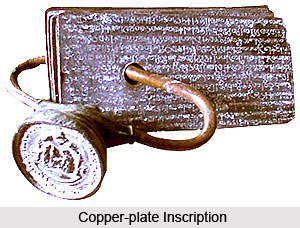South India, a land flooded with Temple towns, mysterious, myth, and the beauty is also called the land of inscriptions. Majority of the epigraphs found in India are situated in the southern states, with Tamil Nadu having the maximum number of inscriptions. These inscriptions are of two types-the lithic inscriptions which are found carved on temple walls and those found inscribed on sheets of copper-plates. While the lithic type is very numerous, the copper-plate records are not as plentiful. However, this paucity is more than made up by the fact that these copper-plate inscriptions are replete with historical facts and together with the stone records, have benefited the historians and archaeologists. This has led in retracing the history of the numerous ruling houses which were left untouched over the periods.
These copper-plate inscriptions, issued by almost all the major dynasties and also some of the vassal chieftains, have been accidentally discovered at various times and in different places. The farmers found it lay beneath the earth and discovered while ploughing their fields.  The copper-plate inscriptions have sometimes been found stored in rooms locked centuries ago and never opened, and also sometimes in old abandoned houses. Fascinating as they seem, these copper-plate inscriptions are broad sheets of copper, held together by a thick ring and crowned by the seal of the dynasty which issued it. The discovery and decipherment of these epigraphs serves as a matter of great exhilaration to historians and students of epigraphy.
The copper-plate inscriptions have sometimes been found stored in rooms locked centuries ago and never opened, and also sometimes in old abandoned houses. Fascinating as they seem, these copper-plate inscriptions are broad sheets of copper, held together by a thick ring and crowned by the seal of the dynasty which issued it. The discovery and decipherment of these epigraphs serves as a matter of great exhilaration to historians and students of epigraphy.
The copper-plate inscriptions usually give detailed information about the grant of land to temples or to scholars noted for their intellectual capabilities by the ruling king. They were meant to be a record given to the donee and to the donee`s family for safekeeping. The copperplate inscriptions are written according to a prescribed format. Starting with one or more verses in Sanskrit in praise of deities, they go on to give the lineage of the king who issued this record and then describe the grant in detail such as the name of the village or the land in the village which was donated, the name of the donee and some details about the donee`s family.
Even the name of the copyist who engraved the inscriptions have not been left out, nor the names of the officials and helpers who assessed the land and actually participated in the entire proceedings. While the first part of the inscription is usually in Sanskrit, the second portion, giving the details of the grant is normally in the language of the area in which it is issued, such as Tamil, Telugu or Kannada.
These copper-plate inscriptions as a rule conclude with imprecise verses with a curse on all those who may, in future, dare to take away or tamper with the gift or grant given to the donees.



















